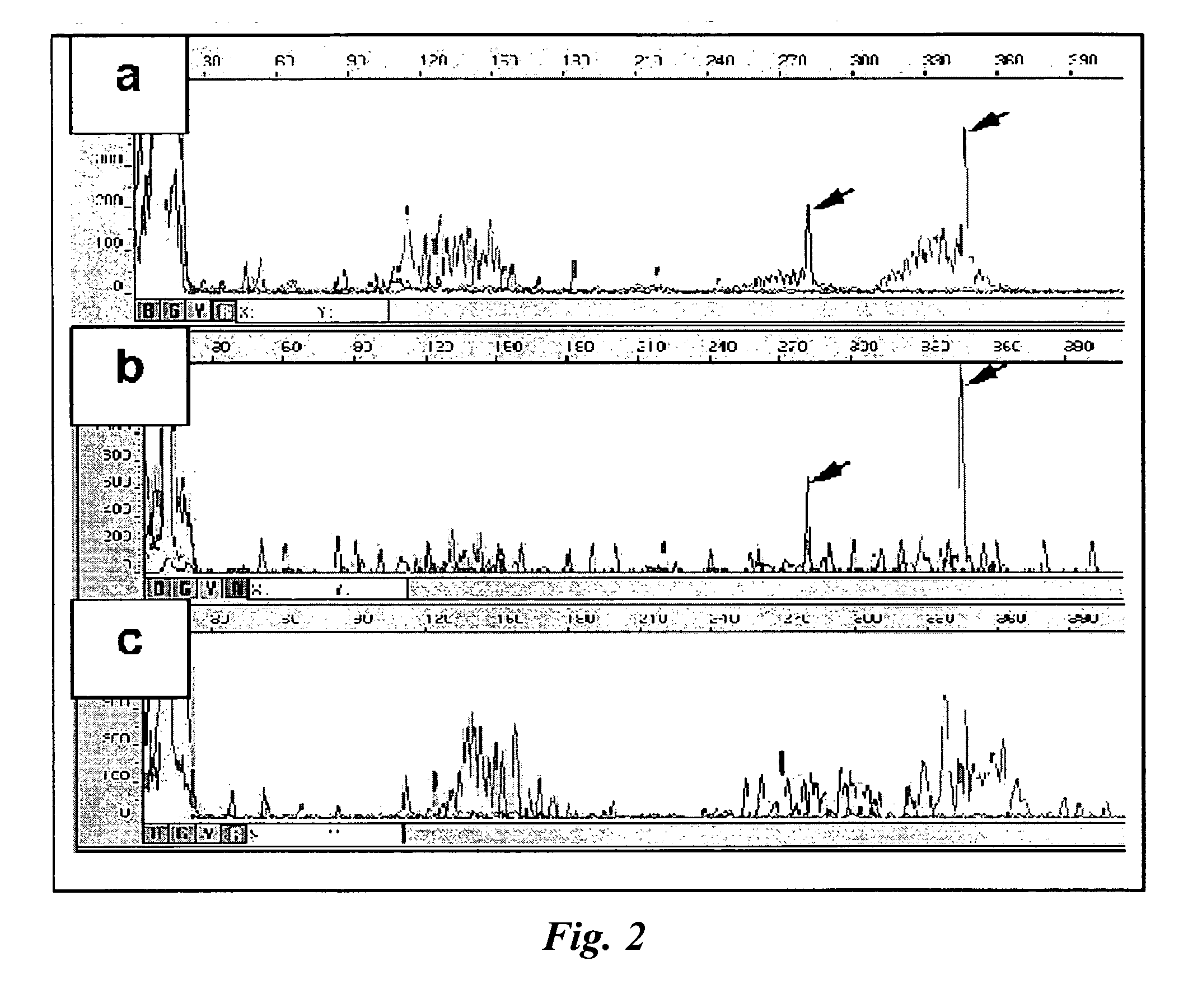[0049] One
advantage of the present invention is that very few cells are needed for
genetic analysis to confirm the presence of minimal disease. Thus, in certain embodiments, the number of
sorted cells to be analyzed can be about 2000,1500, 1000, 950, 900, 850, 800, 750, 700, 650, 600, 550, 500, 450, 400, 350, 300, 250, 200 or fewer cells.
[0050] Following detection of minimal disease using
flow cytometry fluorescence activated
cell sorting, the
sorted cells are subjected to
genetic analysis using any of a variety of reagents and techniques known in the art and described for example, in Current Protocols in
Molecular Biology (John Wiley & Sons, NY, N.Y.), or Innis, Ed., PCR Protocols, Academic Press (1990). In this regard, any
genetic analysis that confirms that the sorted
population of cells represents minimal disease is contemplated for use herein. The genetic analysis to be performed will depend on the disease setting and can be determined by the skilled artisan. One
advantage of the present invention is that the confirmatory genetic analysis does not require patient-specific reagents. However, such reagents can be used where available if desired.
[0051]
Nucleic acid from the
sorted cells is isolated using techniques known in the art such as described in Current Protocols in
Molecular Biology (John Wiley & Sons, NY, N.Y.) or using any of a variety of commercially available reagents. The
nucleic acid for subsequent analysis may be
genomic DNA,
RNA, including HnRNA and mRNA, or cDNA.
[0052] Examples of subsequent analysis which may be performed on samples of genetic material isolated from the sorted
cell population of interest include, but are not limited to,
polymerase chain reaction (PCR),
ligase chain reaction (LCR),
reverse transcriptase initiated PCR (RT-PCR),
DNA or
RNA hybridization techniques including
restriction fragment length polymorphism (RFLP) and other techniques using genetic probes such as
fluorescence in situ hybridization (FISH),
DNA analysis by
variable number of tandem repeats (VNTR) or short tandem repeats (STR), or other
genotype analysis, CpG
methylation analysis (see, for example, Cottrell et al., Nucleic Acids Research 2004; Vol. 32, No. 1 e10),
genomic sequencing, enzymatic assays,
affinity labeling, methods of detection using labels or antibodies and other similar methods.
[0053] The genetic analysis may involve the use of oligonucleotides. As used herein oligonucleotides is used as the term is normally understood in the art, that is, to mean a
short string of nucleotides. In this regard, the oligonucleotides can be used as either primers or probes and can be of varying lengths as is appropriate for the
molecular technique they are being used for, such as PCR, RT-PCR, hybridization assays, FISH, and the like. Generally oligonucleotides are from about 8-50 nucleotides in length but they can be shorter or much longer. In some embodiments, the oligonucleotides can be 10,11, 12, 13, 14, 15, 16, 17, 18, 19, 20, 21, 22, 23, 24, 25, 26, 27, 28, 29, 30, 31, 32, 33, 34, 35, 36, 37, 38, 39, 40, 41, 42, 43, 44, 45, 46, 47, 48, 49, 50, 51, 52, 53, 54, 55, 56, 57, 58, 59, 60, or more nucleotides in length. In certain embodiments, the oligonucleotides can be 65, 70, 75, 80, 85, 90, 95, 100, 105,110, 115,120, 130, 140, 150, or even 200 nucleotides in length. As would be recognized by the skilled artisan, oligonucleotides can be synthesized or otherwise constructed using techniques well known in the art.
[0054] In one embodiment, the genetic analysis comprises the detection of a translocation event. Illustrative translocation events include, but are not limited to: BCR-
ABL; BCL1 / JH t(11;14); BCL2 / JH t(14;18); BCR /
ABL t(9;22); PML / RAR t(15;17); translocations involving MLL and any of its translocation partners (e.g., AF4, AF6, AF9, ENL and ELL), the t(10;11)(p12;q23) translocation, which is a recurrent event in
acute myeloid leukemias; c-myc (8q24) translocations involving t(8;14) (translocations involving t(8;14) occurs in less than 5% of human
multiple myeloma cases, but between 10 to 20% of tumors have genetic abnormalities near this locus (Bergsagel, 1998); Bcl-1 / PRAD-1 /
cyclin D1 (11q13). A cluster of translocation events occur in this locus resulting in
chronic lymphocytic leukemia (CLL) and
lymphoma; FGFR3 and / or MMSET (4p16.3) Approximately 25% of myeloma has translocation of the
receptor tyrosine kinase FGFR3 to the IgH locus; MUM1 / IRF4 / ICSAT / PIP / LSIRF (6p25) IRF4 is a member of the
interferon regulatory factor family which are know to be involved in B-cell proliferation and differentiation. This recurrent translocation was seen in 2 of 11 MM;
Cyclin D3 (6p21) is overexpressed in ˜3% of
multiple myeloma cell lines and ˜4% of primary
multiple myeloma tumors; c-maf (16q23) Translocation of c-maf into the IgH locus results in overexpression of c-maf in approximately 25% of multiple
myeloma cell lines. And other translocation events known in the art. Translocation events can be detected using any of a variety of techniques known in the art, such as by FISH and PCR.
 Login to View More
Login to View More 


